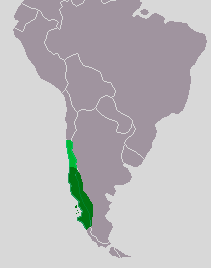Habitat
The kodkod (Leopardus guigna) resides mainly in
heavily forested areas where Nothofagus (pine trees) are
present. Many types of shrubs and bushes are additional forms of
coverage in these places. Temperate forests average about 75° F
and can get up to 150 cm of precipitation each year, typically
in the form of rainfall. This biome experiences all four
seasons: summer, fall, winter, and spring. Winter is not as
prevalent due to this particular biome’s location. It is rather
close to the equator, so, even though it is classified as a
temperate forest, there is more summer than any other season. These
forests are very humid year-round.
than any other season. These
forests are very humid year-round.
L. guigna is extremely specialized when it comes to habitat. Although kodkods are difficult to monitor or detect their specific territories, they specifically reside in the temperate forests of Chile and Argentina, and their living area rarely exceeds latitudes below 30° S or above 50° S (Galvez et. al 2013). It is believed that the kodkod may be a specialized species because it is a small animal. Larger animals tend to have a larger habitat range than smaller animals (Freer 2004). Along with the kodkod, other animals living in Chilean and Argentinean forests are the hog-nosed skunk, grisons, the culpeo fox, and the southern pudu (Simonetti et. al 2013).
Figure 3. This image is a map of where the
kodkod resides in South America. It can be
found at
Wikimedia Commons.
Kodkods are in danger of losing their very specific habitat
(Galvez et. al 2013; Freer 2004). Prior to pine tree
plantations forming all around the Chilean coasts, the forests
of Chile would severely impacted by the amount of deforesting in
common kodkod habitats, forcing this species to live elsewhere.
Protected areas have been reserved in Chile and Argentina, but
these areas are high in the mountains, are extremely windy, and
do not offer much protection from tree coverage. Moreover, these
protected areas are not where kodkod would typically live.
According to Rachel Freer (2004), these two factors have
contributed in the decline of kodkods in South America. They are
now labeled as an endangered species in Chile, and a vulnerable
species in Argentina.
Head to the adaptation page for more information, or go back to the homepage.